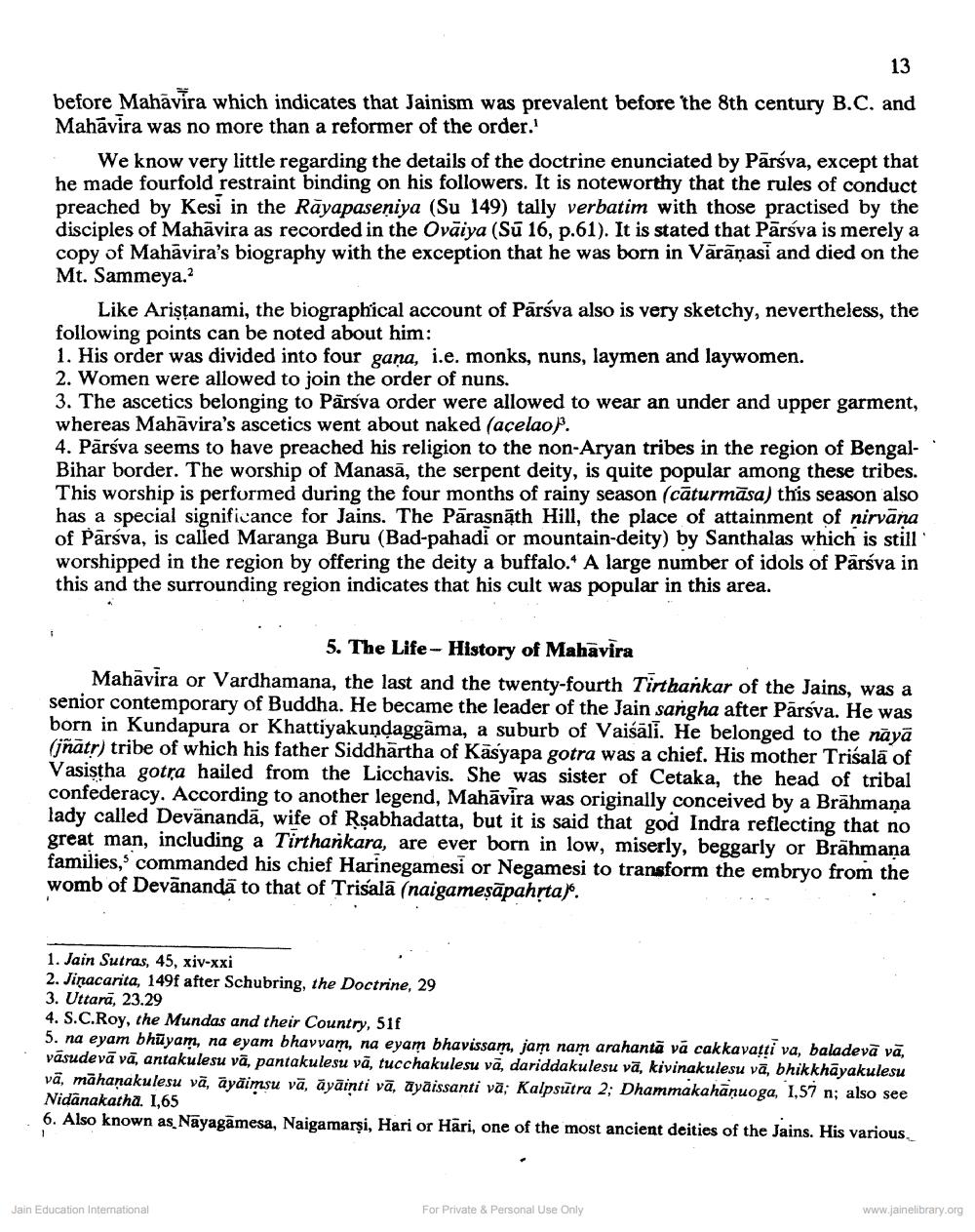________________
13
before Mahavira which indicates that Jainism was prevalent before the 8th century B.C. and Mahāvira was no more than a reformer of the order.'
We know very little regarding the details of the doctrine enunciated by Pārsva, except that he made fourfold restraint binding on his followers. It is noteworthy that the rules of conduct preached by Kesi in the Rāyapaseniya (Su 149) tally verbatim with those practised by the disciples of Mahāvira as recorded in the Ovāiya (Sū 16, p.61). It is stated that Pārsva is merely a copy of Mahavira's biography with the exception that he was born in Vārāṇasi and died on the Mt. Sammeya.?
Like Ariştanami, the biographical account of Pārsva also is very sketchy, nevertheless, the following points can be noted about him: 1. His order was divided into four gana, i.e. monks, nuns, laymen and laywomen. 2. Women were allowed to join the order of nuns. 3. The ascetics belonging to Pārsva order were allowed to wear an under and upper garment, whereas Mahavira's ascetics went about naked (acelao). 4. Pārsva seems to have preached his religion to the non-Aryan tribes in the region of BengalBihar border. The worship of Manasā, the serpent deity, is quite popular among these tribes. This worship is performed during the four months of rainy season (cāturmāsa) this season also has a special significance for Jains. The Pārasnāth Hill, the place of attainment of nirvāna of Parsva, is called Maranga Buru (Bad-pahadi or mountain-deity) by Santhalas which is still worshipped in the region by offering the deity a buffalo. A large number of idols of Parsva in this and the surrounding region indicates that his cult was popular in this area.
5. The Life - History of Mahavira Mahavira or Vardhamana, the last and the twenty-fourth Tirthankar of the Jains, was a senior contemporary of Buddha. He became the leader of the Jain sangha after Parsva. He was born in Kundapura or Khattiyakundaggama, a suburb of Vaisāli. He belonged to the nāyā (nātr) tribe of which his father Siddhartha of Käsyapa gotra was a chief. His mother Trisalā of Vasistha gotra hailed from the Licchavis. She was sister of Cetaka, the head of tribal confederacy. According to another legend, Mahāvira was originally conceived by a Brāhmaṇa lady called Devanandā, wife of Rşabhadatta, but it is said that god Indra reflecting that no great man, including a Tirtharkara, are ever born in low, miserly, beggarly or Brāhmana families, commanded his chief Harinegamesi or Negamesi to transform the embryo from the womb of Devānandā to that of Trisalā (naigamesāpahṛta).
the Licchavis. Kasyapa gotra was a chile belonged to the was
1. Jain Sutras, 45, xiv-xxi 2. Jinacarita, 149f after Schubring, the Doctrine, 29 3. Uttara, 23.29 4. S.C.Roy, the Mundas and their Country, 51f 5. na eyam bhūyam, na eyam bhavvam, na eyam bhavissam, jam nam arahantā vā cakkavatti va, baladevā vā, vasudevā vā, antakulesu vā, pantakulesu vā, tucchakulesu vā, dariddakulesu vā, kivinakulesu vā, bhikkhayakulesu vā, māhanakulesu vä, āyāimsu vā, āyāinti vā, dyāissanti vā; Kalpsūtra 2; Dhammakahānuoga, 1,57 n; also see Nidānakatha. 1,65 6. Also known as Nayagāmesa, Naigamarși, Hari or Hāri, one of the most ancient deities of the Jains. His various
Jain Education International
For Private & Personal Use Only
www.jainelibrary.org




